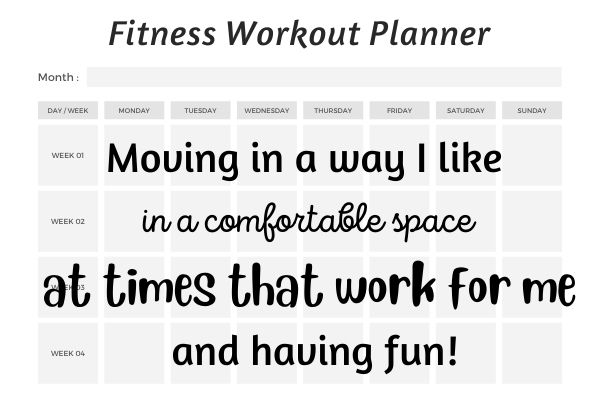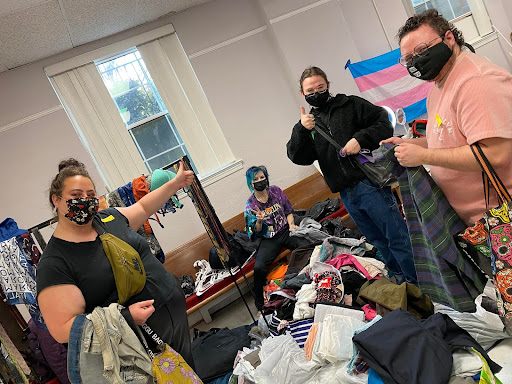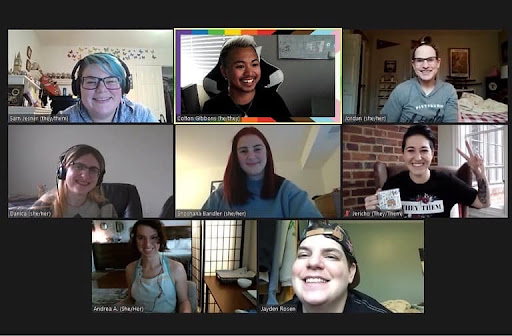Today’s blog is a long one (but worth it, we hope!) Our blog series for February and March is focused on moving your fabulous trans and/or queer body. Sarah Rasmussen (Sarah) starts us off by rethinking exercise. Prior to having COVID in 2020, Sarah ran ultramarathons. Post-COVID and navigating long-COVID has necessitated a redefinition of exercise. Then, Colton Gibbons (he/they) of CAKE Society Co. joins us to talk about his experiences as a trans exercise professional and creating inclusive movement spaces.
Redefining Exercise - The Why

Sarah is finishing Florida State University’s Master of Social Work program. Sarah works as an advocate for survivors and victims of sexual and inter-partner violence. Sarah enjoys adventuring in the wilderness with her dog, regardless of the weather. Notably, some adventures are more fun than others.
The health benefits of exercise are well documented. Regular exercise increases energy levels, improves sleep quality, decreases symptoms of depression, improves self-confidence, body image, and physical and mental health. It is also well documented that most people believe that exercise is hard, must hurt, is time-consuming and expensive, zero fun, and is crucial to losing weight and getting fit. Unfortunately, these widely held beliefs are not only untrue, but they actually cancel out all the benefits that regular exercise offers. By changing our relationship with exercise, we can be healthier physically and mentally and be more comfortable in our bodies.

What Can Exercise Do For Me?
While regular exercise certainly improves one’s health, exercise is not a magic bullet that guarantees weight loss. Studies have found that while exercise helps maintain weight, it does not promote weight loss. Consider this simplified calories in vs. calories out equation:
A 500-calorie muffin equals approximately 3 hours of walking or 5 miles of running to “burn off.”
Now let’s say that you are using more calories (muffins) than you’re consuming. If this happens every now and again, it’s not usually a big deal. However, if you regularly consume fewer calories than you put out, your body will switch to survival mode.
Our bodies are pretty amazing, they have evolved to help us survive all kinds of things, including scarcity. If the body is not receiving the calories it needs to function, it assumes there’s a food scarcity. Since the body has no idea how long this ‘scarcity’ will last, it’ll slow down metabolic functions and start hoarding calories (muffins), causing weight gain to ensure the survival of you and future generations.
While my muffin analogy is a gross oversimplification of an incredibly complex system, using the calorie in/calorie out equation as the basis for a weight loss plan, will ultimately lead to an emotional rollercoaster of weight fluctuations.

This rollercoaster can increase depression, anxiety, body dysmorphia, and long term weight gain, and trash self-esteem.
Deciding to redefine your relationship with exercise for weight loss to being active because it feels good and you want to can be the motivation you need to increase in your activity levels.
As your activity levels increase, you can expect to see an increase in strength, stamina, lean muscle mass, and a shift in body composition. However, an individual’s hormones will ultimately dictate the increase in muscle mass. Those with higher testosterone levels will experience a faster and more significant increase in muscle mass, while those with higher estrogen levels will experience a slower and smaller increase in lean muscle mass.
Regardless of who you are, exercise is unlikely to turn you into The Rock. While certain exercise programs are designed for increasing muscle mass and bulking up, they require a remarkable amount of dedication and lifestyle changes. The good news? They are also easily avoided. If you are concerned about gaining too much muscle mass, skip the strength training.
Helpful Tips For Getting Active and Liking It
Set obtainable goals.
Just because you’re exercising doesn’t mean you’re ”in training.” You don’t need to be fit enough to finish an Ironman Triathlon, fast enough to qualify for the Boston Marathon, or strong enough to deadlift your body weight. Ideally, the goal of regular exercise is to support you in doing the things you want to do, like a Zoom dance party with your friends, playing with your kid on the playground, climbing the stairs to your apartment, or walking a mile. Everyone’s goals will be different and are legitimate.
Setting small achievable goals makes them easier to accomplish and accomplishment can be the motivation needed to set and obtain new goals. For each goal successfully achieved your self-efficacy or confidence in your abilities will increase. With time, you may look forward to exercising because it feels good to be such a bad-ass rocking all of your goals.
If You Don’t Want To Exercise, Be Active
You don’t have to run or “exercise” everyday to experience the health benefits of being active. It has been found that only 22 minutes of activity a day can improve our health. Think of movement as being divided into exercise and activity.
Exercise is any movement or activity done for the sole purpose of being active.
Activity is the physical movement required by our daily lives.
Taking out the trash, walking the dog, vacuuming, shoveling snow, grocery shopping, gardening, and having sex are all examples of activity. If you can get 22 minutes of activity throughout your day, you are improving your health. The best part? Pretty much all movement counts.





Set Yourself Up…For Success!
Finally, set yourself up for success. If you’re not a morning person and you hate running, getting up at 5 am to sneak a run in before work is probably not a routine you’ll stick to.
Let’s face it.
If exercise is not fun and you don’t feel better for doing it, you’re not going to do it. So experiment. Figure out what activities you like, and find the people you enjoy being active with.
Some questions to ask yourself:
What time of day am I most likely to be active?
Do I like to exercise alone? With a partner? In a group?
Do I want to be outside? At home? In a gym? A studio?
Do I feel safe, comfortable, and supported where I exercise?
Remember, not all gyms and studios are the same. Just because one doesn’t feel right doesn’t mean none will feel right.
There is no one way that exercise looks. Whether it’s a community yoga class, following weightlifting classes on YouTube at home, spin class in a gym, or walking with a friend, it all counts. What matters is that you find something that makes you feel good and you look forward to doing.
Count The Little Wins, Too!
If you try something and don’t like it, you’ve just had a win! You tried something new, and that’s huge. The experience of trying something different, maybe even a little uncomfortable, might just empower you to try something else on another day. Plus you now know more about what you like and what you don’t like. Gathering information is good! Look at you go, rockstar!
Inclusive Spaces

Hey there QueerDoc friends, my name is Colton Gibbons and I’m the founder and Executive Director of CAKE Society Co. Before transitioning, I was a full time personal trainer, group fitness instructor, and general fitness professional. Later on, and a few years further in my process, I finished my Masters in Sports Industry Management.
I decided to use the combination of my lived experience and academic training to create one of the first ever health, wellness, and fitness 501c3 nonprofits for the Trans and Gender-Expansive community.
CAKE Society Co. offers multiple services through this lens, ranging from clothing exchanges through our Gender-Affirming Essential Fund, to inclusive social events, to full blown cardio-dance classes!
CAKE stands for Community, Activism, Kindness and Equity. The meaning of the term CAKE is also symbolic for the equity and inclusivity we believe the trans and gender-expansive community has historically not received, and deserves. As someone who has been in the fitness industry both before and during my transition, I realized there was a the lack of inclusive spaces for trans and queer identifying folx. Inclusivity for me means all types of accessibility issues ranging from lack of gender-neutral bathrooms, safe locker room arrangements, misgendering problems, and more. These types of problems led to the creation of my organization. All of our services center the trans and queer community through health, wellness and fitness accessibility!
Right now we are working on creating inclusive exercise spaces for the trans and queer community both in-person and online. By providing opportunities for everyone to express their identity safely, happily, and with support, we believe we can also make a positive mental health impact! For my organization, this looks like being intentional with music selection, pronoun display, placing our classes in supportive environments and truly listening to the feedback of our members. Without trans and queer-centered decisions being made, our community can never be justly served. That is why in order for us to create inclusive spaces, we use client feedback and survey forms as a way of knowing if people feel comfortable and accommodated in a safe space.
When we host health and fitness classes, we also make sure everyone feels comfortable and welcomed through intentional language. This means we want our word choices, and how we speak to our clients to match our intentions. Body positivity, empowerment and all body and fitness level inclusivity is something we truly promote in our health and fitness environment. We believe this impacts our clients tremendously.
“The joy of being in a room with so many other trans people :)”
Sam (he/him,) a member who attended one of our events
Having inclusive spaces means encouraging participation and engagement for community members that may not typically find this in other places. Systemically, we know inclusivity and trans and queer-centered services are limited. That is why our efforts to provide a welcoming and inclusive environment is one of our biggest priorities.
If you’re interested in learning more please visit our website at https://www.cakesocietyco.org/.
Next week, we’ll dive a little deeper into the mental health benefits that Sarah discussed. Please let us know who about your favorite inclusive movement people and places via a comment!




